Spider plants are very easy to grow, and don’t require any special care. In this complete guide, I’ll tell you all you need to know in order to keep yours thriving for decades to come.
With their long, arching stems and lush foliage, spider plants are a classic choice for beginners and experts alike.
They are super popular, and make a wonderful addition to any plant collection, either indoors or outside.
In this detailed growing guide, I will show you exactly how to care for spider plants so you will have the best success.
Below you’ll find everything you need, from hardiness and location, to sunlight, watering, soil, fertilizer, pests, propagation, fixing common problems, and much more!
Spider Plant Quick Care Overview
| Scientific name: | Chlorophytum comosum |
| Classification: | Tropical plant |
| Common names: | Spider Plant, Airplane Plant |
| Hardiness: | Zones 10+ |
| Temperature: | 60-90°F |
| Flowers: | White, blooms spring through summer |
| Light: | Partial to full shade, bright light indoors |
| Water: | Keep soil evenly moist, do not overwater |
| Humidity: | Average to high |
| Fertilizer: | General purpose plant food spring-summer |
| Soil: | Fast-draining, fertile soil |
| Common pests: | Mealybugs, whiteflies, spider mites, scale |
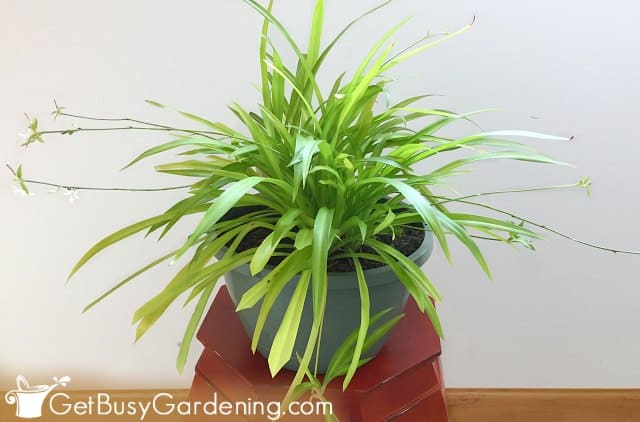
Information About Spider Plants
Chlorophytum comosum, more commonly known as a spider plant, is native to southern Africa. But it’s grown as a houseplant throughout the world.
When given the proper care, this fast-growing plant can reach its full size of 12-24 inches within a few years.
The long arching stems will eventually develop babies on the ends. This distinctive quality is the reason it’s sometimes called an “airplane plant”.
As an added benefit, it is an air-purifying houseplant. So, be sure to place it in a spot where it will bring you joy, as well as improve your indoor air quality.
Different Types Of Spider Plants
There are several spider plant varieties to choose from, but they all fall into two broad categories: variegated or solid leaf.
The most common type of variegated spider plant has one white stripe that runs down the center of each leaf.
But you can also find ones that have green down the center with white stripes on the outsides of the leaves.
Since the foliage adds additional visual interest, the variegated types tend to be more popular than the plain green ones.
There are also curly leaf varieties (the most common cultivar is called “Bonnie”) which make a fun addition to your collection too.
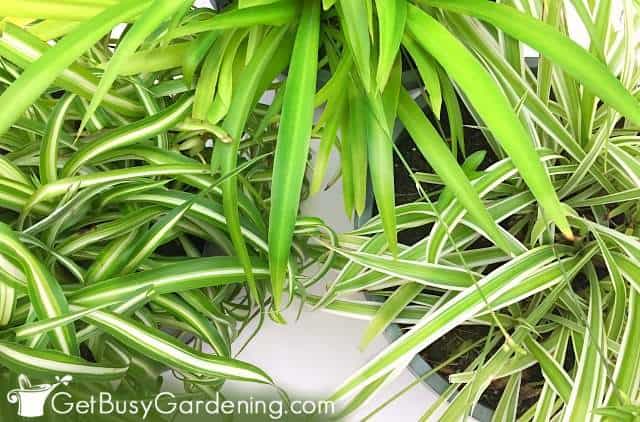
Flowers
With the proper care, spider plants will bloom almost all year round, but they are most prolific in the late winter through early fall.
The small white flowers develop at the ends of long arching stems. If they’re pollinated, they will produce seeds.
Otherwise small plantlets (aka: babies, pups, spiderettes, or offshoots) will form as the flower starts to fade.
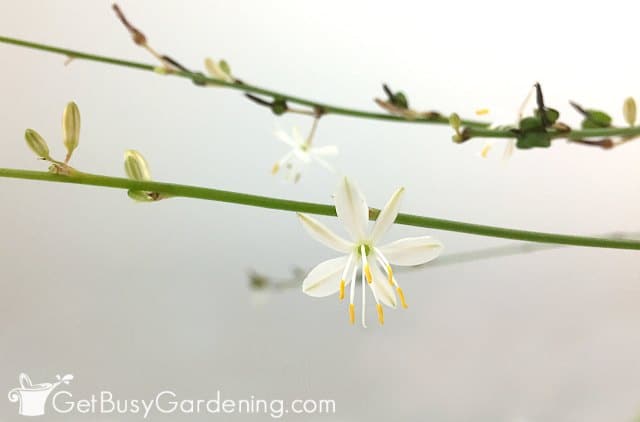
Toxicity
The good news is that spider plants are non-toxic, and won’t poison your cat or dog if they decided to chew on it.
For this reason, they made my list of the top pet friendly houseplants. You can learn more about it on the ASPCA website.
How To Grow Spider Plants
Learning how to care for spider plants is very important, but first we need to talk about where to grow them. Finding the perfect spot will set you up for the best success.
Hardiness
Though most commonly grown as a houseplant or an annual, spider plants are actually evergreen perennials in their native habitat.
But they’re not very hardy, and can only live outdoors year round in growing zones 10 and above.
They can survive short periods of cold weather, but if it ever stays below 30°F where you live, you must bring them indoors.
Where To Grow Spider Plants
Since spider plants are tender perennials, most of us need to grow them indoors during the winter months.
However, you can also put them outside for the summer. Just be sure to bring it back inside before the temps dip below 50°F in the fall.
If you live in a warm enough climate, then you can grow airplane plants right in your garden. Choose a full to part shade location that has rich, fast-draining soil.
Spider Plant Care & Growing Instructions
The good news is that, no matter which type you grow, spider plant care is the same for all. These instructions will help you provide exactly what they need to flourish.
Sunlight Requirements
Direct sunlight, especially during the summer, is too intense for spider plants. Too much sun will cause dull foliage and unattractive brown spots or sunburn.
Ideally they like bright, indirect sunlight indoors, or full to partial shade outside. However, they do need plenty of light in order to produce offshoots and bloom.
So if yours won’t flower or produce babies, then it’s probably getting too much shade. Move it to a brighter location, or use a grow light indoors.
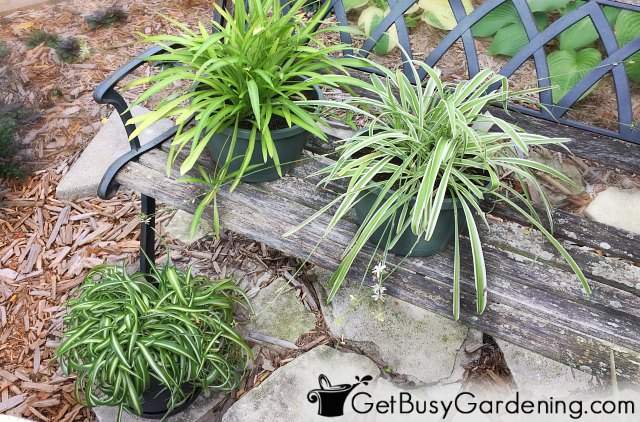
Watering
Proper watering is an important part of successful spider plant care. Ideally they need consistent moisture, but don’t like to be saturated.
Never stress your plant by allowing it to dry out frequently. Overly dry soil will cause the leaves to turn brown and die back.
When the top 1″ of has dried, it’s time to give them more. A moisture gauge will help you give yours the perfect amount every time.
One other important thing to note is that they are sensitive to the chemicals and salts found in tap water. So it’s best to use rainwater or distilled to prevent problems.
Learn more in my complete guide for how to water spider plants.
Humidity
Chlorophytum comosum also thrive in high humidity, which is why they love growing outside during the summer.
They don’t like overly dry air, which can cause a host of problems, and is especially a problem indoors during the winter.
So periodic misting, or running a humidifier nearby, will help your plant look great indoors all year long.
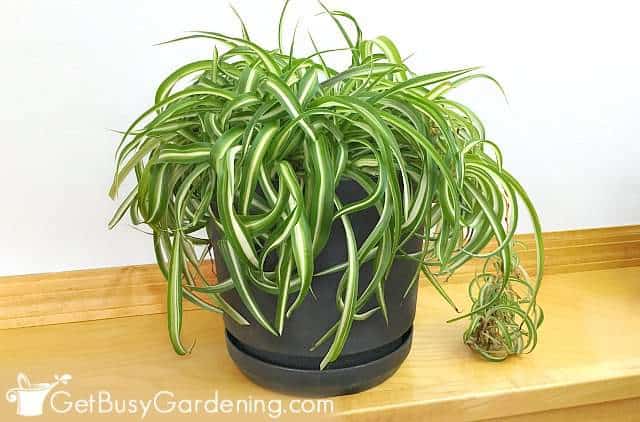
Temperature
The ideal temperature range for growing Chlorophytum comosum is between from 60-90°F.
They can survive cooler temperatures, but will start to suffer if it’s consistently below 50°F. Spider plants will die if the temperature stays below 30°F.
Hotter temps don’t usually bother them. But if it gets above 90°F, keep them shaded. You also may need to water more often, especially in an arid climates.
Soil
When it comes to choosing the best medium for growing spider plants, you don’t have to worry too much. They’re not super fussy and don’t need a special mixture.
However, they do require good drainage, and also do best in a nutrient-rich medium. Therefore, be sure to invest in a high-quality potting mix for them.
Another option is mixing your own by combining 2 parts peat moss with 1 part pine bark, 1/2 part coarse sand, and 1/4 part perlite. Learn more about choosing and making spider plant soil.
Repotting
Since they are such fast growers, airplane plants can become root-bound very quickly. But they actually like being tight in their pot, and can survive that way for a long time.
However if you wait too long, their health will begin to decline. So, many people make repotting a part of their regular spider plant care routine.
The best time to size them up is in the spring. Choose a container that’s slightly larger than the current one, and be sure it has drainage holes.
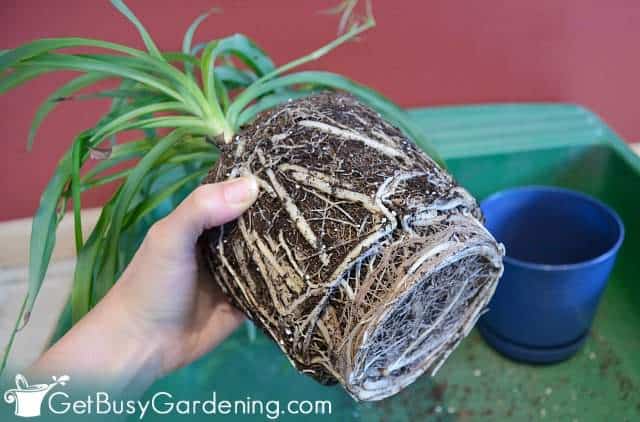
Fertilizer Needs
Since spider plants aren’t heavy feeders, fertilizer isn’t an essential part of their care. But of course they do benefit from being fed.
However, they are sensitive to chemicals. Synthetic fertilizers can easily burn them or cause the leaf tips to turn brown. So, I highly recommend using organic options instead.
Start in early spring to stimulate healthy new summer growth. Then feed them monthly with a liquid compost tea or a general purpose one.
Or top-dress with slow-release granules a couple of times throughout the summer. Stop fertilizing in the fall, and don’t feed them at all through the winter.
Pest Control Tips
Fortunately, spider plants are relatively pest-free, and the best defense against any infestation is to maintain proper care.
However, mealybugs, whiteflies, spider mites, or scale can sometimes become a problem, especially indoors.
If you spot any bugs, gently wash them off with an organic insecticidal soap. You can also make your own by mixing 1 teaspoon mild liquid soap with 1 liter of water.
Neem oil also works great to get rid of bugs and keep them from coming back.
Pruning
To keep your spider plant growing and looking its best, make pruning a part of your regular care routine.
Simply trim off any brown tips or edges using a sharp pair of micro snips, and following the natural angle of the leaf. Pinch or cut dead or yellowing leaves down to the base.
You can trim off dead or dying offshoots and flower spikes at any time, simply cut them all the way back to the bottom.
Tips For Propagating Spider Plants
Propagating new spider plants is not only easy, it’s fun, and there are a couple of ways to do it. By far the most common method is to remove the babies and root them, learn how to do it here.
However, they can also be grown from seed. Simply allow the pods to dry on the plant before collecting and planting the seeds.
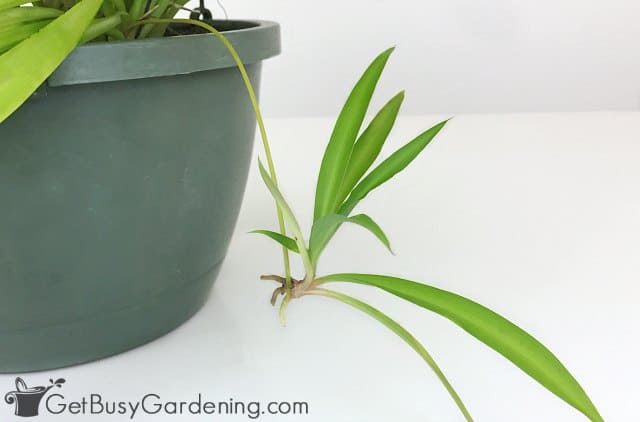
Troubleshooting Common Problems
Once you get the hang of it, spider plant care is pretty darn easy. However, there are a few very common problems that you’ll likely see over time. Below are the most common, and tips for fixing them.
Leaves Turning Brown
Brown spider plant leaves are usually caused by under watering or sunburn. Extended periods of drought will cause the leaves to die back.
This is common for plants that are pot-bound. If that’s the case, then put yours into a bigger container. Otherwise keep the soil evenly moist, and make sure they’ve never in direct sunlight.
Brown Leaf Tips Or Margins
Spider plants are notorious for brown tips and leaf margins. This is usually caused by salt and chemical buildup (either synthetic fertilizers, or city water), improper watering (over or under), or lack of humidity.
Learn more about all of the possible causes of brown tips and how to fix them here.
Yellow Leaves
This one is a lot harder to diagnose, because yellow spider plant leaves can be caused by a lot of different things.
Most likely it’s because of a chemical or salt buildup in the soil (from synthetic fertilizer and/or tap water), overwatering, not enough light, a bug infestation, or it needs to be repotted.
Brown Spots On The Leaves
The most common cause of brown leaf spots on spider plants is too much sun. If your plant gets any direct exposure at all, then move it to a shadier spot.
Otherwise, if you’re sure the lighting is perfect, then it could be bacterial leaf blight. In that case, it needs better air circulation.
No Flowers, Babies, Or Long Stems
Spider plants won’t flower (or grow long stems and babies) if they don’t get enough light or nutrients.
Move your plant into spot where it will get bright, indirect sun, or use a grow light. If you’ve never fed it before, then try giving it an organic fertilizer in the spring through summer.
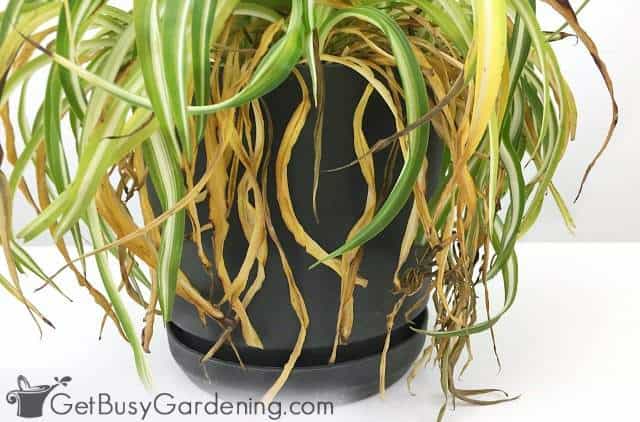
Spider Plant Care FAQs
Below I will answer some of the most frequently asked questions about spider plant care. If you have one that wasn’t answered here, then add it to the comments section below.
Is Chlorophytum comosum poisonous?
No, thankfully Chlorophytum comosum is not poisonous to pets, so they are safe to grow around cats and dogs.
How fast do spider plants grow?
Spider plants grow quite fast, with the proper care it only takes a few years for them to reach full maturity. In ideal conditions, they can put on several inches of new growth per year.
How long do spider plants live?
Spider plants can live for many years, even several decades with the proper care. My mother has had hers for at least 30 years, maybe more, and it’s still going strong.
Is an airplane plant and spider plant the same thing?
Yes, airplane plants and spider plants are the same thing. Both are common the names used for a Chlorophytum comosum.
Should I cut the babies off my spider plant?
Whether you cut the babies off your spider plant is up to you, either way it’s not going to hurt. But if the stem they’re growing on has been damaged, or it’s turning yellow or brown, then you should cut the babies off and root them. They won’t survive long without a healthy green stem.
Once you get the hang of the basic spider plant care needs, you’ll see just how easy it is to grow them. With this detailed guide, you’ll be able to keep yours thriving for many, many years.
If you want to learn all there is to know about maintaining healthy indoor plants, then you need my Houseplant Care eBook. It will show you everything you need to know about how to keep every plant in your home thriving. Download your copy now!
More Articles About Growing Houseplants
- How To Care For A Lipstick Plant
- How To Care For Corn Plants (Dracaena fragrans)
- Wandering Jew Plant Care Guide
- How To Care For Dieffenbachia (Dumb Cane)
- How To Care For Heart Leaf Philodendron (Philodendron hederaceum)
Share your spider plant care and growing tips in the comments section below!

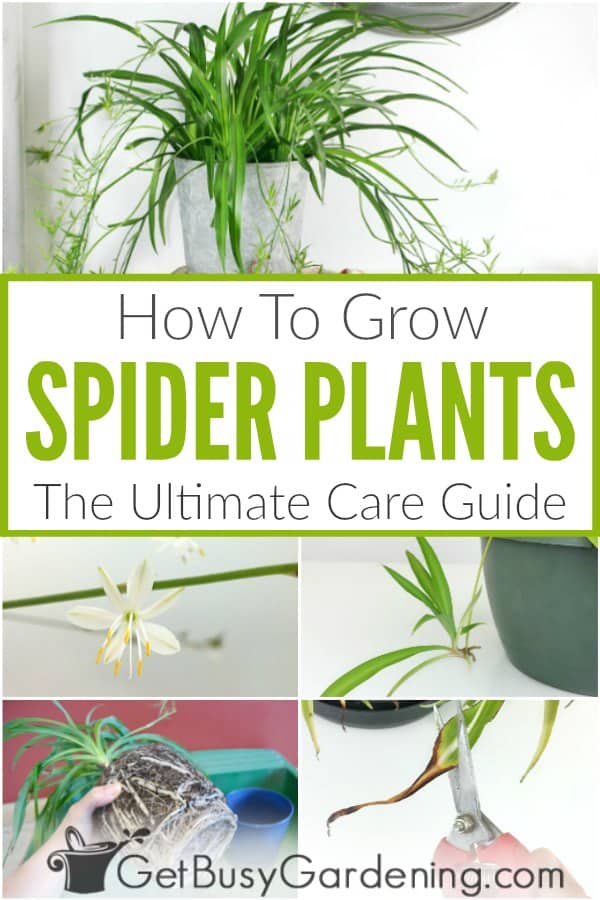

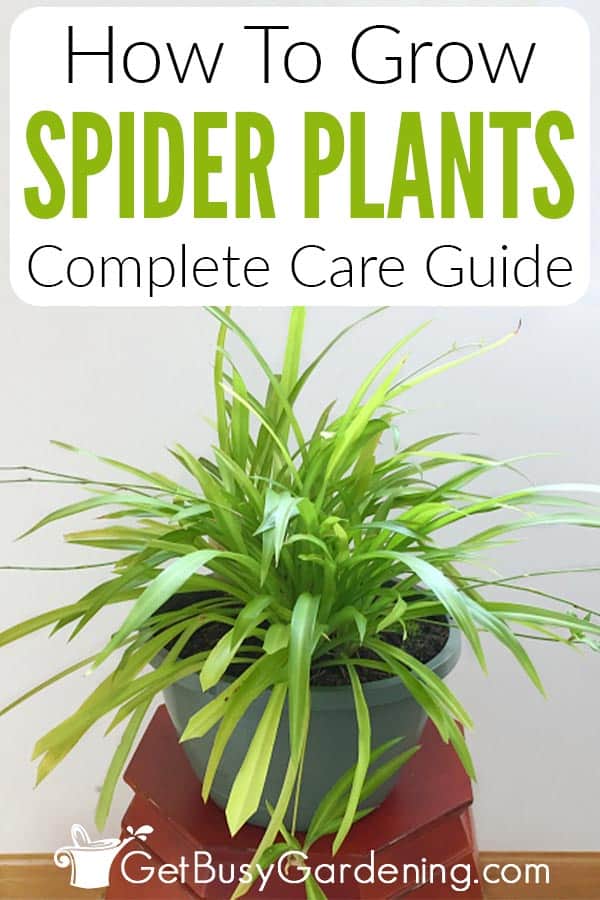
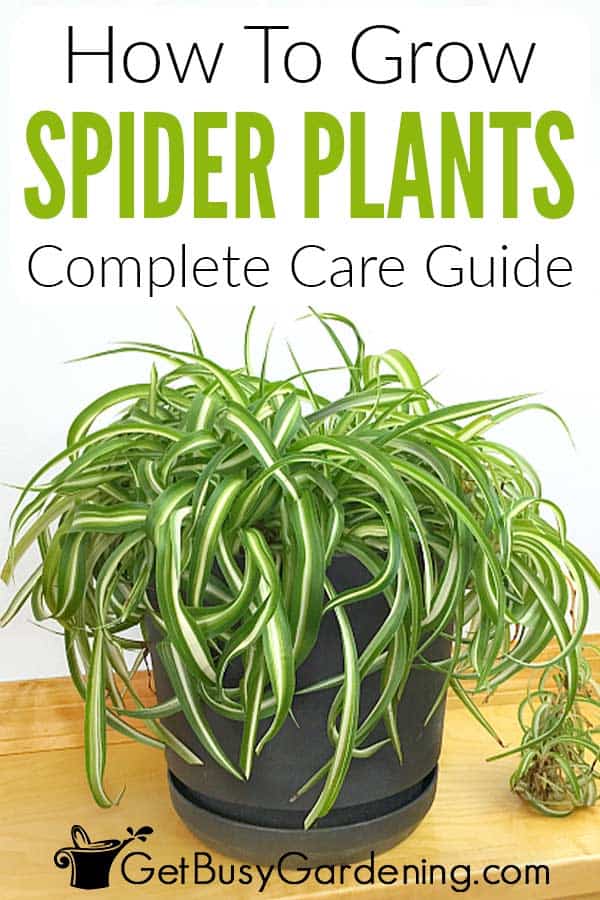
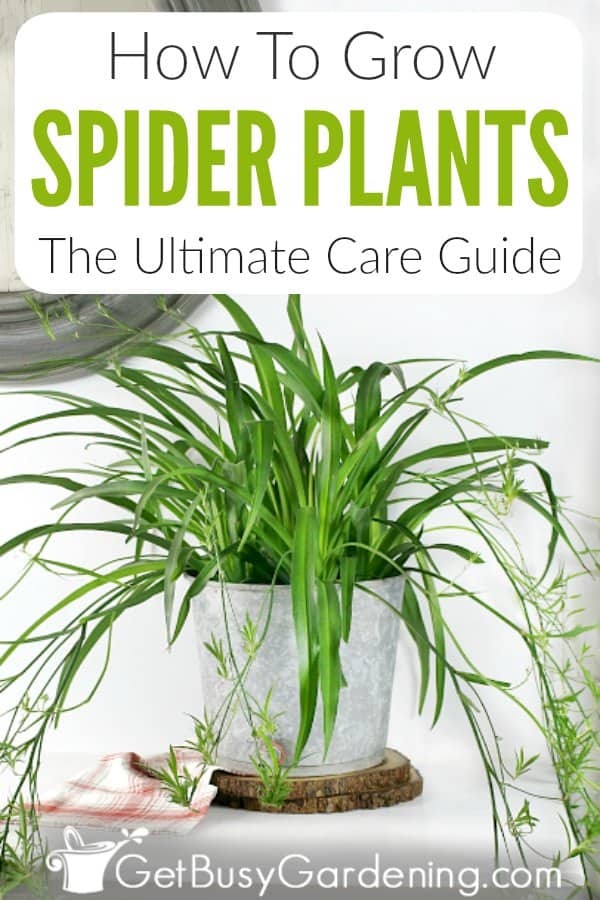
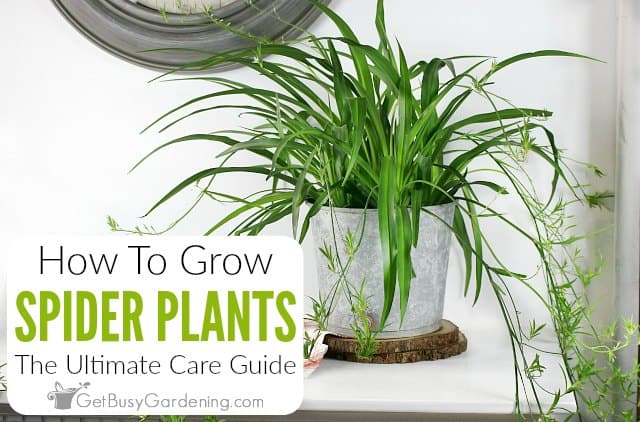


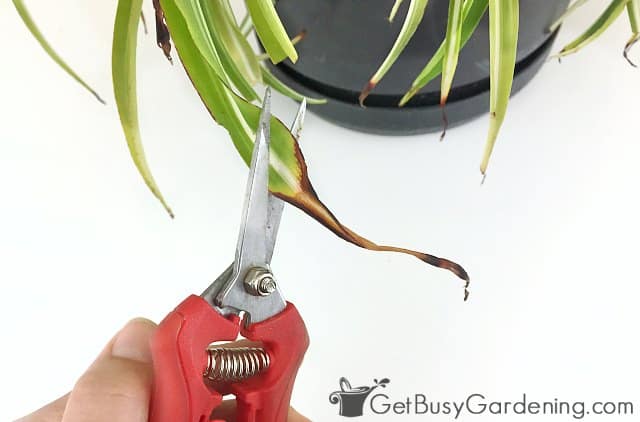


Betsy says
I have just planted the babies in soil. I would like to take the spider plant into my classroom when school stars in August. How long until they become rooted? And how will I know they are rooted? And, how long until my babies make babies? I would love to let my students have a baby to grow on their own…
Amy Andrychowicz says
Here’s all the details about how to propagate spider plants that will answer most of your questions. I’ve seen babies growing from babies, so as long as your plants get the proper care and lots of light, they can form their own babies at any age.
Nic says
How to manage floppy or flopped over section of a spider Plant?
How to trim to grow bushier spider Plant ?
Amy Andrychowicz says
The best way to encourage busier and more compact growth on your spider plant is to give it more light. They can grow leggy when they don’t get enough. So either move it to a brighter (indirect sun) location, or add a grow light.
Shutterbug says
I repotted my spider plant and I think it’s in shock, what can I do to save it?
Amy Andrychowicz says
The best thing to do is to leave it alone and don’t try to do anything to save it. Just monitor your spider plant to make sure it has an adequate amount of water (the soil should be on the dry side, never wet). Don’t try to move it or repot it again like that, they just need time to recover, so it’s best to leave it be, it should pop back in a week or so.
suesan a arth says
my big spider is in the south facing window. during winter we get some sun. should i pull the semi transparent window blind down to diffuse the light? i am noticing brown tips and the soil feels ok.
Amy Andrychowicz says
Yes, a south facing window it too intense for spider plants. It might be ok there in the winter, since it’s less intense, but I would definitely move it a few feet away during the summer so it doesn’t get too hot or burned. Yes, if you don’t want to move it, you could pull down the shade during the day to give it diffused light. Here’s an article about what causes brown tips and how to fix them that you might find helpful.
Laura says
I bought a spider plant from Lowe’s it felt very dry I gave it a good drink. Did I do wrong.
Amy Andrychowicz says
Adding water when the soil on a snake plant feels dry is the right thing to do. It should never be completely bone dry, or the plant will start to struggle.